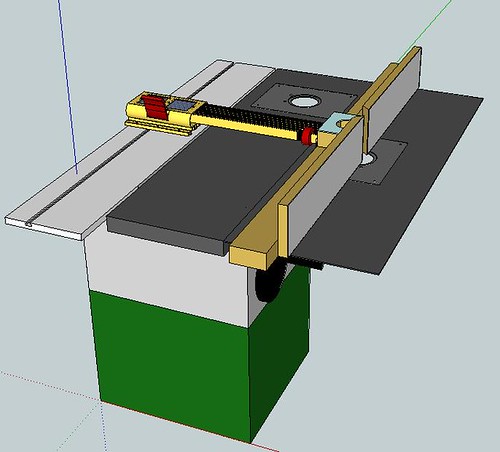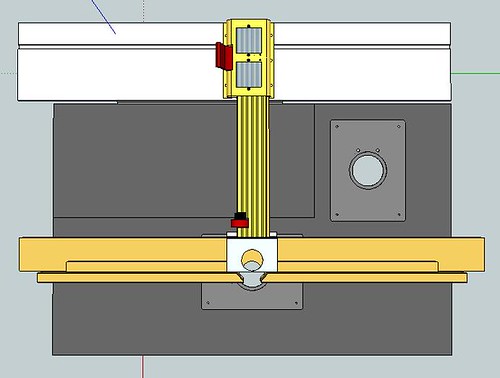siggy_7
Full time tool collector, part time woodworker
I've been mulling over how to accommodate a router into my table saw for a while now, and after a few design iterations I've come up with the following:


The concept is a 3mm mild steel L-shaped extension wing, mounted onto 36mm of MDF. I haven't drawn in the MDF yet, or any additional supports for the extension, although I plan to include some.
There are two router insert plates of 6mm thick mild steel, 310x230mm (my router is a Triton which is 300mm between the handles). The choice of mild steel is to make it compatible with magnetic hold downs and featherboards, thereby removing the need for a T-track. The fence is made of several bits of hardwood, with 1" thick plywood faces which are laminated, 6" high and 22" long. The faces are independently moveable, and can be adjusted by shimming for jointing (the design is based on one of Bill Hylton's). There is a vertical 63mm dust extraction port set back from the centre of the fence, 4" above the table face. The fence attaches to a 430mm Incra LS Positioner, which I intend to attach via a fixture which will clamp into the T-slot on the table saw sliding beam (the beam travel will be locked). If the LS clamping is not rigid enough (unlikely from what I've seen), the fence is a bit longer than the table so I can fashion a clamp to the front rail of the saw (not yet built into the model) and to the underside of the table at the back. The infeed and outfeed measure 24" each, with 10" from the edge of the table to the centre of the router (the opening is 95mm).
I had the idea to put a second position for the router at the outfeed end of the table saw. The idea here is that I can use the sliding beam with a fence in place of a mitre gauge or sled, more like the sort of thing you get on a spindle moulder. The rip fence on the table saw attaches via a T-slot and a couple of bolts, so I plan to make a second fence that can attach to this in place of the table saw rip fence, and clamp under the table at the other end. I could also use this fence with the other router position for situations in which I need more than the 10" of support in front of the bit, such as when edge routing large panels.
I'd be interested to hear other's thoughts on the design, where it can be improved and any limitations I'm likely to come up against.


The concept is a 3mm mild steel L-shaped extension wing, mounted onto 36mm of MDF. I haven't drawn in the MDF yet, or any additional supports for the extension, although I plan to include some.
There are two router insert plates of 6mm thick mild steel, 310x230mm (my router is a Triton which is 300mm between the handles). The choice of mild steel is to make it compatible with magnetic hold downs and featherboards, thereby removing the need for a T-track. The fence is made of several bits of hardwood, with 1" thick plywood faces which are laminated, 6" high and 22" long. The faces are independently moveable, and can be adjusted by shimming for jointing (the design is based on one of Bill Hylton's). There is a vertical 63mm dust extraction port set back from the centre of the fence, 4" above the table face. The fence attaches to a 430mm Incra LS Positioner, which I intend to attach via a fixture which will clamp into the T-slot on the table saw sliding beam (the beam travel will be locked). If the LS clamping is not rigid enough (unlikely from what I've seen), the fence is a bit longer than the table so I can fashion a clamp to the front rail of the saw (not yet built into the model) and to the underside of the table at the back. The infeed and outfeed measure 24" each, with 10" from the edge of the table to the centre of the router (the opening is 95mm).
I had the idea to put a second position for the router at the outfeed end of the table saw. The idea here is that I can use the sliding beam with a fence in place of a mitre gauge or sled, more like the sort of thing you get on a spindle moulder. The rip fence on the table saw attaches via a T-slot and a couple of bolts, so I plan to make a second fence that can attach to this in place of the table saw rip fence, and clamp under the table at the other end. I could also use this fence with the other router position for situations in which I need more than the 10" of support in front of the bit, such as when edge routing large panels.
I'd be interested to hear other's thoughts on the design, where it can be improved and any limitations I'm likely to come up against.

































